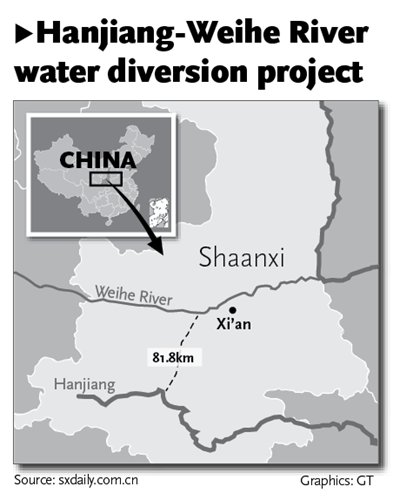
Holding aloft a glass cylinder, Wang Hongchun, director of the wetland office at the Taibai Lake Scenic Area in Jining, East China's Shandong Province, could not hold back his enthusiasm for how clean the water is these days after a huge improvement in environmental protection.
Wang told the Global Times that previously, the "ancient canal," the Jining section of the Grand Canal, was heavily polluted and local residents called it the "soy sauce river." However, since the government invested about 67 million yuan ($9.6 million) into pollution in 2012, the water quality has massively improved.
The massive environmental protection campaign was part of the country's largest water diversion project, which has transferred 1.1 billion cubic meters of water from the southern Yangtze River to Shandong since the first stage of the eastern route started in December 2013.
However, many experts pointed out that the project has led to drops in the water level of the Hanjiang River, a Yangtze tributary, further polluting the river's water and leading to a sharp decline in fish numbers. Such worries have escalated after Northwest China's Shaanxi Province, a parched region, also started a project that plans to take water from the Hanjiang to supplement its Weishui River.
Looting liquid
The Shaanxi government started the diversion project at the end of 2014, which is supposed to bring water from the Hanjiang over the Qinling Mountains to the Weishui, the largest tributary of the Yellow River. This aims to relieve a severe water shortage for both businesses and residents in four major cities as well as 11 counties, costing 36.8 billion yuan.
Ever since Shaanxi revealed the plan in 2009, Hubei Province, which lies on the middle and lower reaches of the Hanjiang, has been fighting it. Three engineers from the Hubei Provincial Water Resources and Hydropower Planning Survey and Design Institute issued a report in 2010, claiming that the project will deepen problems on the middle and lower reaches of the Hanjiang as Shaanxi plans to transfer about 1.5 billion cubic meters of water from the upper reaches by 2030.
The report also pointed out that the middle route of the south-to-north water diversion project, together with the Shaanxi water diversion project, will lead to a drop in the water level of the Hanjing, a decline in the groundwater level, a drop in water quality and desertification.
A 2015 report from Hubei's Changjiang Daily estimated that if the two projects start to operate in 2017, the middle and lower reaches of the Hanjiang will lose at least 10.5 billion cubic meters of water, one-fifth of the river's annual runoff, which will create problems for irrigation, civilian water supply and pollution in Hubei.
Shi Weixin, chief designer of the south-to-north water diversion project in Beijing told the Global Times that the water diversion project will make no big difference to the water source as the amount of water that has been and will be transferred to northern areas has been calculated based on in-depth research.
But Shi refused to comment on whether the Shaanxi water diversion project would affect the Hanjing.
However, according to previous media reports, many officials from Shaanxi Provincial Water Resources Department have claimed that the project will have a limited impact on ecosystem of the Qinling Mountains, which stand between Hanjiang and Weishui River, but will bring huge benefits to Shaanxi.
Air corridor
As the western route of the south-to-north water diversion project is still a work in progress due to the region's high altitude, complex terrain and fragile ecosystems, Wang Guangqian, an academician with the Chinese Academy of Sciences and president of Qinghai University, has proposed an ambitious project that would transfer water from Tibet's Yarlung Zangbo River to the Xinjiang Uyghur Autonomous Region via an "air corridor."
Calling his plan the "Tianhe Project" (literally, "a river in the sky"), Wang introduced his proposal at a meeting in September, saying that China could use the atmospheric boundary layer and the troposphere to form a passage through which water vapor can be transported in a stable and orderly way.
In theory, the project will divert 5 billion cubic meters of water per year, an amount equivalent to 350 West Lakes in Hangzhou, Zhejiang Province, to alleviate water shortages in the Yellow River Basin, Wang said.
However, many experts also questioned the feasibility of the project, saying that the project costs too much and lacks sufficient experimental basis.


















































